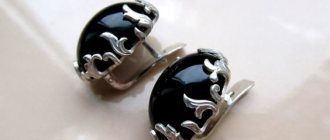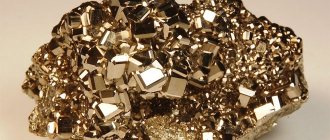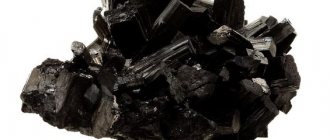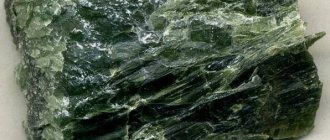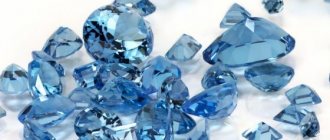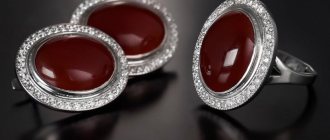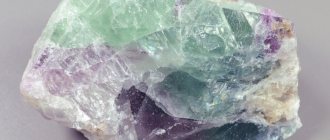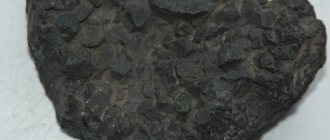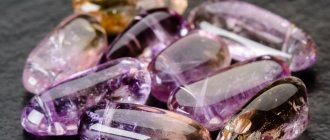Mineral iron(II) disulfide
"Fool's Gold" redirects here. For other uses, see Fool's Gold (disambiguation).
This article is about iron pyrite. For other pyrite minerals, see pyrite group.
Mineral pyrite
(/ˈraɪraɪt/), [1] or
iron pyrite
, also known as
fool's gold
, is an iron sulfide with the chemical formula 2 (iron(II) disulfide). Pyrite is the most common sulfide mineral.
| Pyrite | |
| Cubic pyrite crystals | |
| General | |
| Category | Sulfide mineral |
| Formula (repeating unit) | FeS 2 |
| Strunz classification | 2.EB.05a |
| Dana classification | 2.12.1.1 |
| Crystal system | Isometric |
| Crystal class | Diploid (m3) symbol HM: (2/m3) |
| Space group | P a 3 |
| Cell | a = 5.417, Z = 4 |
| Identification | |
| Mass formula | 119.98 g/mol |
| Color | Pale yellow brass reflector; fades to darker and shimmering |
| Crystal Habit | Cubic faces may be grooved, but can often be octahedral or pyritohedral. Often ingrown, massive, radiant, granular, spherical and stalactite. |
| Twinning | Penetration and contact twinning |
| Split | Fuzzy on {001}; goodbyes to {011} and {111} |
| Fracture | Very uneven, sometimes shell-like |
| Perseverance | Fragile |
| Mohs hardness | 6–6,5 |
| Shine | Metallic, shiny |
| Band | Greenish-black to brownish-black |
| Transparency | Opaque |
| Specific gravity | 4,95–5,10 |
| Density | 4.8–5 g/cm3 |
| Fusibility | 2.5–3 in magnetic globule |
| Solubility | Insoluble in water |
| Other characteristics | paramagnetic |
| Recommendations | [2] [3] [4] [5] |
Pyrite cubic crystals on marl from Navajun, La Rioja, Spain (size: 95 by 78 millimeters [3.7 by 3.1 in], 512 g [18.1 oz]; Main crystal: 31 mm [1.2 in] ] on the edge)
Pyrite's metallic luster and pale copper-yellow hue give it an appearance similar to gold, hence its famous nickname "fool's gold"
.
The color has also led to the nicknames brass
,
brazzle,
and
Brazil
, which are primarily used to refer to the pyrite found in coal. [6] [7]
Name pyrite
comes from the Greek πυρίτης λίθος (
pyritēs lithos
), "stone or mineral that strikes fire"[8], in turn from πῦρ (
pyr
), "fire". [9] In ancient Roman times, the name was applied to several types of stones that created sparks when struck against steel; Pliny the Elder described one of them as copper, almost certainly referring to what we now call pyrite. [10]
By the time of George Agricola, c. In 1550 the term became a general term for all sulfide minerals. [eleven]
Pyrite in normal and polarized light
Pyrite is commonly associated with other sulfides or oxides in quartz veins, sedimentary rocks and metamorphic rocks, as well as in coal seams and as a replacement mineral in fossils, but has also been identified in sclerites of squamate-foot gastropods. [12] Despite the nickname "fool's gold", pyrite is sometimes found in combination with small amounts of gold. A significant portion of the gold is "invisible gold" embedded in pyrite (see Carlin-type gold deposit). It has been suggested that the presence of both gold and arsenic is a case of related substitution, but as of 1997 the chemical state of gold remained ambiguous. [13]
CONTENT
- 1 Use
- 2 Research
- 3 Formal oxidation states of pyrite, marcasite and arsenopyrite
- 4 Crystallography
- 5 Crystal Habit
- 6 varieties
- 7 How to distinguish similar minerals
- 8 Hazards 8.1 Pyrite oxidation and acid mine drainage
- 8.2 Dust explosions
- 8.3 Weakened building materials
Uses [edit]
An abandoned pyrite mine near Pernek in Slovakia.
Pyrite enjoyed short-lived popularity in the 16th and 17th centuries as an ignition source in early firearms, most notably the wheellock, where a sample of pyrite was placed against a round file to create the sparks needed to ignite the weapon. [14]
Pyrite was used with flint and a form of tinder made from stringybark by the Kaurna people, Aboriginal Australians of South Australia, as a traditional method of starting fires. [15]
Pyrite has been used since classical times to produce copper
(ferrous sulfate). Iron pyrite was piled up and left to weather (an example of an early form of heap leaching). The acidic runoff from the heap was then boiled with iron to produce ferrous sulfate. In the 15th century, new methods of such leaching began to replace the burning of sulfur as a source of sulfuric acid. By the 19th century it had become the dominant method. [16]
Pyrite continues to be used commercially to produce sulfur dioxide, for use in areas such as the paper industry and sulfuric acid production. Thermal decomposition of pyrite into FeS (iron(II) sulfide) and elemental sulfur begins at 540 °C (1004 °F); at about 700 °C (1292 °F) p
S2 is about 1 atm. [17]
A new commercial use of pyrite is as a cathode material in Energizer brand non-rechargeable lithium batteries. [18]
Pyrite is a semiconductor material with a bandgap of 0.95 eV. [19] Pure pyrite is naturally n-type, in both crystalline and thin-film forms, possibly due to sulfur vacancies in the pyrite crystalline structure acting as n-impurities. [20]
In the early years of the 20th century, pyrite was used as a mineral detector in radio receivers, and is still used by radio amateurs today. Until the perfection of the vacuum tube, the crystal detector was the most sensitive and reliable detector available—with significant differences between mineral types and even individual samples within a particular mineral type. Pyrite detectors were intermediate between those of galena and the more mechanically complex pericone mineral pairs. Pyrite detectors can be as sensitive as the modern 1N34A germanium diode detector. [21] [22]
Pyrite has been proposed as an abundant, non-toxic, and inexpensive material for low-cost photovoltaic solar panels. [23] Synthetic iron sulfide was used with copper sulfide to create a photovoltaic material. [24] Recent efforts have focused on creating thin-film solar cells made entirely of pyrite. [20]
Pyrite is used to make marcasite jewelry. Marcasite jewelry, made from small faceted pieces of pyrite, often set in silver, has been known since ancient times and was popular during the Victorian era. [25] At the time the term became common in jewelry, "marcasite" referred to all iron sulfides, including pyrite, rather than to marcasite of the orthorhombic mineral FeS 2. which is lighter in color, brittle and chemically unstable and therefore not Suitable for making jewelry. Marcasite jewelry does not actually contain the mineral marcasite. Pyrite samples, if they appear to be good quality crystals, are used in decoration. They are also very popular when collecting minerals. Among the sites that provide the best examples are the provinces of Soria and La Rioja (Spain). [26]
In value terms, China ($47 million) represents the world's largest market for imported unfired iron pyrites, accounting for 65% of global imports. China is also the fastest growing in terms of imports of unfired iron pyrites with a CAGR of +27.8% from 2007 to 2016 [27].
Cost of pyrite samples
It’s worth starting with unprocessed crystals, which at current prices cost 1000 rubles per 2 cm3 cube. This is a good option for mineralogical collections.
Pyrite beads, collected in threads approximately 40 cm long, cost about 900-1000 rubles with a bead diameter of up to 7 mm. The stone is often used to make “ritual,” sacred and “magical” figurines.
So a Buddha figurine 15 centimeters high and about 8 centimeters wide can cost from 12 to 15 thousand rubles. Since the times of the ancient Chinese dynasties, pyrite has been famous among Asian peoples as a special stone that has become a symbol of well-being, wealth and prosperity.
Research[edit]
In July 2022, scientists reported that they had observed the stress-induced transformation of normally diamagnetic pyrite into a ferromagnetic material, which could lead to its use in devices such as solar cells or magnetic data storage. [28] [29] Researchers at Trinity College Dublin, Ireland, have demonstrated that FeS 2 can be exfoliated into multiple layers, like other two-dimensional layered materials such as graphene, by a simple liquid-phase exfoliation process. This is the first study to demonstrate the preparation of non-layered 2D platelets from bulk 3D FeS 2. In addition, they used these 2D platelets with 20% single-walled carbon nanotube as anode material in lithium-ion batteries, achieving a capacity of 1000 mAh/g, close to to the theoretical capacity of FeS 2. [thirty]
Formal oxidation states of pyrite, marcasite and arsenopyrite[edit]
In terms of classical inorganic chemistry, which assigns formal oxidation states to each atom, pyrite is probably best described as Fe 2+ S 2 2– . This formalism recognizes that the sulfur atoms in pyrite occur in pairs with distinct S–S bonds. These persulfide units can be considered as derivatives of hydrogen sulfide H 2 S 2 . Thus, pyrite would be more descriptively called iron persulfide rather than iron disulfide. In contrast, molybdenite, MoS2, has isolated sulfide (S2-) centers, and the oxidation state of molybdenum is Mo4+. The mineral arsenopyrite has the formula Fe As S. While pyrite has S2 subunits, arsenopyrite has units [ AsS], formally obtained by deprotonation of arsenothiol (H 2 AsSH). Analysis of classical oxidation states would recommend a description of arsenopyrite as Fe 3+ [AsS] 3– . [31]
How much is jester's gold worth?
The cost of the figurines depends, of course, on the fineness of the work, the price of the frame, the size of the figurines and how highly the master values his work.
- A 1x1 cm cube of pyrite sells for 90 to 120 rubles.
- Pyrite beads will cost 2,000-3,500 rubles.
- Balls on a stand (feng shui experts place them in the wealth sector - the southeastern part of the room) are valued depending on their size. The smallest one will cost 2,500 rubles. If you want more, no problem. Question of money.
- They sell elephants and money frogs to attract good luck, wealth and other joys of life. A cute elephant (10x8x5 cm) can be purchased for 12,000 rubles.
- Collectors will appreciate the polished, processed section of a pyritized ammonite. A rather large exhibit, 28x25x3.5 cm, costs about 30,000 rubles.
Unprocessed pyrite is sold at a price of 0.01-0.2 US$ per gram.
Is it worth counterfeiting pyrite?
Yes, “fool’s gold” is also counterfeited. In the most primitive way - plastic or coated glass - here you have that “gold”. No need to process fragile stone. And the prices for fakes are simply shameless. A thread of glass or plastic that imitates pyrite will sell for 600-700 instead of a hundred rubles.
It's easy to spot a fake. Look at the light - real iron disulfide is always opaque. You can run your fingernail over the surface of the product. The coating is always thin, and if a scratch is formed, this means that they are “making a fool” of you.
Related publications
- RAUCHTOPAZ: smoky chameleon stone
- Solution Stone WHITE JADE
- Application of SNOW QUARTZ
- SAPPHIRE STONE
Crystallography[edit]
Crystal structure of pyrite. In the center of the cell, the S 2 2− pair is visible in yellow.
Iron pyrite FeS 2 is the prototypical compound of the pyrite crystallographic structure. The structure is simple cubic and was one of the first crystal structures solved by X-ray diffraction. [32] It belongs to the crystallographic space group Pa
3 and is designated Strukturbericht designation C2.
Under standard thermodynamic conditions, the lattice constant of stoichiometric iron pyrite FeS 2 is 541.87 pm. [33] The unit cell consists of a Fe a {\displaystyle a} face-centered cubic sublattice into which S2 ions are embedded. (Note, however, that the iron atoms at the faces are not equivalent by translation alone to the iron atoms at the corners.) The pyrite structure is also seen in other MX2
transition metal
M
and the chalcogens
X
= O, S, Se and Te.
Some dipnictides with Y
standing for P, As and Sb, etc. Known to also adopt a pyrite structure. [34]
The Fe atoms are bonded to six S atoms, forming a distorted octahedron. Material: semiconductor. Fe ions are generally considered to be low spin
divalent states (as shown by Mössbauer spectroscopy, as well as XPS). The material generally behaves as a van Vleck paramagnet, despite its low-spin divalency. [35]
The sulfur centers are arranged in pairs described as S 2 2– . [36] Reduction of pyrite with potassium gives potassium dithioferrate, KFeS 2 . This material contains ferric ions and isolated sulfide (S 2- ) centers.
The S atoms are tetrahedral and are associated with three Fe centers and another S atom. The symmetry of the sites at the Fe and S positions is explained by the point symmetry groups C
3
i
and
C
3 respectively. The absence of an inversion center at S-lattice sites has important consequences for the crystallographic and physical properties of iron pyrite. These effects are due to the crystal's electric field active at the sulfur lattice site, which causes the polarization of S ions in the pyrite lattice. [37] Polarization can be calculated from higher order Madelung constants and must be included in the lattice energy calculation using the generalized Born–Haber cycle. This reflects the fact that the covalent bond in the sulfur vapor is not adequately accounted for by strictly ionic treatment. [38]
Arsenopyrite has a related structure to As–S heteroatomic pairs rather than to SS pairs. Marcasite also contains pairs of homoatomic anions, but the arrangement of metallic and diatomic anions differs from that of pyrite. Despite the name, chalcopyrite (CuFeS 2) does not contain dianion pairs, but contains single sulfide anions S 2 -.
Features of pyrites
Pyrites are minerals that are selenium, arsenic, antimony, and selenium compounds of iron group metals. Among the representatives of this group we note: nickel, cobalt, platinum, iron. They have a characteristic metallic luster and are colored yellow, gray, and red. All pyrites have excellent hardness, but are considered brittle minerals.
These include systems of hexagonal and rhombic structure:
- regular systems, represented by pyrite, cobalt luster, speiss cobalt, ulmannite, chloanthite;
- Orthorhombic variants include arsenic pyrite and marcasite;
- Millerite, nickelite, magnetic pyrite have a hexagonal system;
- copper pyrite has a square shape.
Crystal habit[edit]
Pyritohedron-shaped crystals from Italy
Pyrite typically forms cuboidal crystals, sometimes forming in close association to form raspberry-shaped masses called framboids. However, under certain circumstances it can form anastomosing threads or T-shaped crystals. [39] Pyrite can also form shapes much like a regular dodecahedron, known as a pyritohedron, and this offers an explanation for artificial geometric patterns found in Europe as early as the 5th century BC. [40] [ clarification required
]
Place of Birth
There are quite a lot of deposits of the mineral pyrite on Earth, but specimens with jewelry properties are found quite rarely. The stone is mined in Scandinavia, Azerbaijan, the USA, and the Urals. Beautiful minerals are often found in Italy.
Pyrite crystals are most often found near hot springs, sulfur or gold deposits. Hence its second name - gold or sulfur pyrite, although technically pyrite is an ore, not a gem.
When copper, nickel, or zinc are smelted from ore, the “by-product” is also often individual crystals of fire rock. Beautiful and large specimens are found when mining quartz veins.
Identifying similar minerals[edit]
Pyrite differs from native gold in its hardness, brittleness and crystalline form. Natural gold is typically rectangular (irregular) in shape, while pyrite is shaped like cubes or polyhedral crystals. Pyrite can often be identified by the stripes that can be seen on its surface in many cases. Chalcopyrite is brighter yellow with a greenish tint when wet and softer (3.5–4 on the Mohs scale). [42] Arsenopyrite is silvery-white in color and does not turn yellow when wet.
Medicinal properties
The energy of pyrite is very strong, it is capable of changing the properties of the human biofield. Thanks to this, such a talisman is able to heal the wearer from a variety of diseases. For depression and neuroses, it restores the will to live and joy, brings peace and allows you to get rid of obsessive thoughts and hopelessness. Flint is also prescribed:
- People who suffer from insomnia and circadian rhythm disorders.
- For those who often suffer from various infectious diseases. The mineral improves the functioning of the immune system and can increase the body's resistance. It is especially good to wear a talisman during autumn-winter flu epidemics.
- Patients who suffer from heart disease. Pyrite improves the elastic properties of blood vessels and blood fluidity, prevents the development of thrombosis, and therefore reduces the risk of myocardial infarction.
- Asthmatics and those diagnosed with chronic obstructive pulmonary disease. Ognevik helps to expand the bronchi and make them more elastic.
- For people who suffer from sexual dysfunction, the crystal will help restore the joy of sexual life.
There is also a belief about the healing properties of the pyrite stone: if you tie it to the leg of a woman giving birth, the birth will take place without complications, bleeding and stretch marks. You can quickly give birth to a healthy baby.
Dangers[edit]
The pyrite cube (center) dissolved away from the host rock, leaving behind traces of gold.
Iron pyrite is unstable on the Earth's surface: iron pyrite, when exposed to atmospheric oxygen and water, decomposes into iron oxides and sulfate. This process is accelerated by the action of Acidithiobacillus bacteria,
which oxidize pyrite to form ferrous iron, sulfate and protons (H+). These reactions occur faster when the pyrite is fine (framboid crystals originally formed by sulfate-reducing bacteria (SRB) in clay sediments or mining dust).
Pyrite oxidation and acid mine drainage[edit]
The sulfate released by the decomposition of pyrite combines with water to form sulfuric acid, leading to acid mine drainage. An example of acid rock drainage caused by pyrite is the 2015 Gold King Mine wastewater spill.
2 FeS 2 ( s ) + 7 O 2 ( gram ) + 2 H 2 O ( l ) ⟶ 2 Fe 2 + ( aq ) + 4 SO 4 2 — ( aq ) + 4 H + ( aq ) {\displaystyle {\ ce {2FeS2 {\scriptstyle (s)} + 7O2 {\scriptstyle (g)} + 2H2O {\scriptstyle (l)} -> 2Fe^{2 +} {\scriptstyle (aq)} + 4SO4 ^{2 -} {\scriptstyle (aq)}+4H+{\scriptstyle (aq)}}}}. [43]
Dust explosions[edit]
Pyrite oxidation is quite exothermic, so that in underground coal mines, severe spontaneous combustion problems sometimes occur in coal seams with high sulfur content. [44] The solution is the use of buffer blasting and the use of various sealing or lining agents to seal the goaf areas to prevent oxygen from entering. [45]
In modern coal mines, limestone dust is sprayed onto exposed coal surfaces to reduce the danger of dust explosions. This has the secondary benefit of neutralizing the acid produced by pyrite oxidation and therefore slowing down the oxidation cycle described above, reducing the likelihood of spontaneous combustion. However, in the long term, oxidation continues and the resulting hydrated sulfates can exert crystallization pressures that can widen cracks in the rock and eventually lead to roof failure. [46]
Weakened building materials[edit]
Building stone containing pyrite tends to turn brown as the pyrite oxidizes. This problem is greatly exacerbated if marcasite is present. [47] The presence of pyrite in aggregate used to make concrete can cause severe deterioration of concrete properties as the pyrite oxidizes. [48] In early 2009, problems with Chinese drywall imported into the United States after Hurricane Katrina were associated with oxidation of pyrite followed by microbial reduction of sulfate, which released hydrogen sulfide. These problems included foul odors and corrosion of copper wiring. [49] In the US, Canada, [50] and most recently in Ireland, [51] [52] [53] where it was used as floor infill, pyrite contamination has caused severe structural damage. Normalized testing of aggregate materials [54] confirms that such materials do not contain pyrite.
Who is pyrite suitable for according to their zodiac sign?
Pyrite stone is associated with the Sun. Signs that were born in the “sunny” summer months - Gemini , Cancer , Leo , Virgo - will be able to achieve career growth with the help of the stone, reveal their inner potential, and find strong and lasting relationships.
- Aries and Sagittarius , thanks to the properties of the gem, will be able to become firmer, calmer, and more confident in themselves.
- Capricorns more purposeful and courageous, and will teach them not to deviate from a given goal.
- Aquarians will find the strength and energy to carry out long-standing plans, or change something that has long been in need of change.
- Libra will be able to become more reasonable and protect themselves from bad company and unnecessary temptations.
It is not recommended to use pyrite for water signs, except for “summer” Cancers: the properties of the stone can conflict with their energy, leading to depression and neuroses.
Incident[edit]
Pyrite is the most common of the sulfide minerals and is widespread in igneous, metamorphic, and sedimentary rocks. It is a common accessory mineral in igneous rocks, where it also sometimes occurs as larger masses arising from the immiscible sulfide phase in the parent magma. It occurs in metamorphic rocks as a product of contact metamorphism. It also forms as a high-temperature hydrothermal mineral, although it sometimes forms at lower temperatures. [2]
Pyrite occurs both as a primary mineral present in the original sediments and as a secondary mineral deposited during diagenesis. [2] Pyrite and marcasite commonly occur as post-fossil replacement pseudomorphs in black shales and other sedimentary rocks formed under deteriorating environmental conditions. [55] Pyrite is common as an accessory mineral in shales, where it forms by precipitation from anoxic seawater, and coal seams often contain significant amounts of pyrite. [56]
Prominent deposits have been found in lenticular masses in Virginia, USA, and in smaller quantities in many other places. Large deposits are being developed at Rio Tinto in Spain and elsewhere in the Iberian Peninsula.
How to distinguish an original from a fake
Pyrite ball on a stand
Pyrites are not created artificially - this is impractical, since the stone is not in great demand among jewelers, is quite common in nature and is inexpensive.
Sometimes pyrite can be passed off as gold, but it is soft, and iron pyrite is hard. Pressing the precious metal will leave a dent; this will not happen with “Inca gold”.
At local markets and resort fairs, you can run into jewelry sellers who want to increase the value of their plastic and glass trinkets by passing them off as energetically powerful iron pyrites. This kind of deception is easy to spot:
- Glass and plastic are light, mineral is heavy.
- Its metallic color cannot be picked off with a fingernail, like a layer of paint on glass, but the stone itself will easily scratch the glass.
- Pyrite is always opaque; glass and plastic can be translucent when viewed in the light.
Images [edit]
- As a mineral substitute in ammonite from France.
- Pyrite from the Ampliación a Victoria mine, Navajún, La Rioja, Spain
- Pyrite from the Sweet Home mine, with gold striped cubes intergrown with minor tetrahedrite, on a bed of clear quartz needles.
- Emitting form of pyrite
- Paraspirifer bownockeri
in pyrite
- Pink fluorite is sandwiched between pyrite on one side and metallic galena on the other.
- SEM image of the intergrowth of cuboctahedral crystals of pyrite (yellow) and pyrrhotite (pinkish-yellow)
Prices for pyrite products
A large industrial quality pyrite nugget can be purchased on the jewelry market for $25-30 per 1 kg. Crystals that are suitable for jewelry purposes are valued at an order of magnitude more expensive. For example, beads made from large pyrite cabochons cost between $80 and $100.
Links[edit]
- Definition of PYRITE | in the Cambridge English Dictionary. dictionary.cambridge.org
. - ^ abc Hurlbut, Cornelius S.; Klein, Cornelis (1985). Manual of Mineralogy (20th ed.). New York, New York: John Wiley and Sons. pp. 285–286. ISBN 978-0-471-80580-9.
- "Pyrite". Webmineral.com
. Retrieved May 25, 2011. - "Pyrite". mindat.org
. Retrieved May 25, 2011. - Anthony, John W.; Bidot, Richard A.; Bladh, Kenneth W.; Nichols, Monte K., ed. (1990). "Pyrite" (PDF). Handbook of Mineralogy
. Volume I (Elements, sulfides, sulfosalts). Chantilly, Virginia, USA: Mineralogical Society of America. ISBN 978-0962209734. |volume=there is additional text (help) - Jackson, Julia A.; Mel, James; Neuendorf, Klaus (2005). Glossary of Geology. American Geological Institute. p. 82. ISBN 9780922152766 - via Google Books.
- Fay, Albert H. (1920). Mining and Mineral Industries Glossary. US Department of Mines. pp. 103–104—via Google Books.
- πυρίτης. Liddell, Henry George; Scott, Robert; The Greek-English lexicon
in the Perseus Project. - πῦρ in Liddell and Scott.
- Dana, James Dwight; Dana, Edward Salisbury (1911). Descriptive Mineralogy (6th ed.). New York: Wiley. paragraph 86.
- "De re Metallica". Mining Magazine
. Translated by Hoover, H. C.; Hoover, L.H. London: Dover. 1950 [1912]. footnote on page 112. - "Armored snail discovered in deep sea". news.nationalgeographic.com
. Washington, DC: National Geographic Society. Retrieved August 29, 2016. - Navy, M.E.; Mumin, A. Hamid (1997). "Auriferous arsenian pyrite, marcasite and arsenopyrite from the Carlin Trend gold deposits and laboratory synthesis" (PDF). American mineralogist
.
82
(1–2): 182–193. Bibcode: 1997AmMin..82..182F. DOI: 10.2138/h 1997-1-220. S2CID 55899431. - Larson, Bruce (01/01/2003). "The Interpretation of Firearms in the Archaeological Record in Virginia 1607-1625." . Dissertations, Dissertations and Master's Projects
. - Rihanna
Schultz, Chester (22 October 2022).
"Place Names Roundup, 23 June: Brukangga and Tyndale use bruki" (PDF). Adelaide Research and Scholarships
. University of Adelaide. Retrieved November 16, 2022. - "Industrial England in the mid-eighteenth century". Nature
.
83
(2113): 264–268. 1910-04-28. Bibcode: 1910Natur..83..264. . DOI: 10.1038/083264a0. hdl:2027/coo1.ark:/13960/t63497b2h. S2CID 34019869. - Rosenquist, Terkel (2004). Fundamentals of Mining Metallurgy (2nd ed.). Tapir Academic Press. paragraph 52. ISBN 978-82-519-1922-7.
- "Cylindrical primary lithium [battery]." Lithium iron disulfide (Li-FeS 2) (PDF). Reference book and instructions for use. Energizer Corporation. 2017-09-19. Retrieved April 20, 2018.
- Ellmer, K. & Tributsch, H. (2000-03-11). "Iron disulfide (pyrite) as a photovoltaic material: challenges and opportunities". Proceedings of the 12th Workshop on Quantum Conversion of Solar Energy - (QUANTSOL 2000)
. Archived from the original on 2010-01-15. - ^ ab Xin Zhang and Mengquin Li (06/19/2017). "A possible solution to the problem of doping in iron pyrite: determining the type of carrier using the Hall effect and thermopower". Materials of physical review
.
1
(1): 015402. Bibcode: 2017PhRvM ... 1a5402Z. DOI: 10.1103/PhysRevMaterials.1.015402. - Principles underlying radio communications. US Army Signal Corps. Radio Brochure. 40
. 1918. section 179, pp 302–305 - via Google Books. - Thomas H. Lee (2004). RF Integrated Circuit Design (2nd ed.). Cambridge, UK: Cambridge University Press. pp. 4–6. ISBN 9780521835398 - via Google Books.
- Wadia, Cyrus; Alivisatos, A. Paul; Kammen, Daniel M. (2009). "Material Availability Expands Opportunities for Large-Scale Photovoltaic Deployment". Environmental Science and Technology
.
43
(6):2072–7. Bibcode: 2009EnST…43.2072W. DOI: 10.1021/es8019534. PMID 19368216. S2CID 36725835. - Sanders, Robert (February 17, 2009). "Cheaper materials may be key to cheaper solar cells". Berkeley, CA: University of California - Berkeley.
- Jump up
↑ Hesse, Rayner W. (2007). Jewelry Making Throughout History: An Encyclopedia. Greenwood Publishing Group. paragraph 15. ISBN 978-0-313-33507-5. - Jump up
↑ Calvo, Miguel and Sevillano, Emilia (1998).
"Pyrite crystals from the provinces of Soria and La Rioja, Spain." Mineralogical record
.
20
: 451–456.CS1 maint: multiple names: authors list (link) - “Which country imports the most unroasted iron pyrite in the world? - IndexBox". www.indexbox.io
. Retrieved September 11, 2022. - "'Fool's Gold' May Be Valuable After All". Phys.org
. Retrieved August 17, 2022. - Walter, Jeff; Voight, Brian; Day-Roberts, Ezra; Heltemes, Kay; Fernandes, Rafael M.; Birol, Turan; Leighton, Chris (1 July 2022). "Stress-induced ferromagnetism in a diamagnetic material". Science is advancing
.
6
(31): eabb7721. Bibcode: 2020SciA…. 6.7721W. DOI: 10.1126/sciadv.abb7721. ISSN 2375-2548. PMC 7439324. PMID 32832693. - Kaur, Harneet; Tian, Ruiyuan; Roy, Ahin; McChrystal, Mark; Horvath, Dominic W.; Onrubia, Guillermo L.; Smith, Ross; Rueter, Manuel; Griffin, Aideen; Backes, Claudia; Nicolosi, Valeria; Coleman, Jonathan N. (September 22, 2022). "Production of quasi-2D non-laminated iron pyrite (FeS 2 ) flakes by liquid phase exfoliation for high performance battery electrodes". Self-propelled gun Nano
.
14
(10):13418–13432. DOI: 10.1021/acsnano.0c05292. PMID 32960568. - ↑
Vaughan, DJ;
Craig, Jr. (1978). Mineral chemistry of metal sulfides
. Cambridge, UK: Cambridge University Press. ISBN 978-0-521-21489-6. - Bragg, W. L. (1913). "The structure of some crystals as indicated by their X-ray diffraction". Proceedings of the Royal Society
A.
89
(610): 248–277. Bibcode: 1913RSPSA..89..248B. DOI: 10.1098/rspa.1913.0083. JSTOR 93488. - Birkholz, M.; Fiechter, S.; Hartmann, A.; Tribuch, H. (1991). "Sulfur deficiency in iron pyrite (FeS 2-x) and its implications for band structure models". Physical Review
B.
43
(14):11926–11936. Bibcode: 1991PhRvB..4311926B. DOI: 10.1103/PhysRevB.43.11926. PMID 9996968. - Brese, Nathaniel E.; von Schnering, Hans Georg (1994). "Binding trends in pyrite and re-examination of the structure of PdAs 2, PdSb 2, PtSb 2 and PtBi 2." Z. Anorg.
Allg. Chem .
620
(3):393–404. DOI: 10.1002/zaac.19946200302. - Burgardt, P.; Seehra, M. S. (1977-04-01). "Magnetic susceptibility of iron pyrite (FeS2) from 4.2 to 620 K." Solid State Communications
.
22
(2): 153–156. Bibcode: 1977SSCom..22..153B. DOI: 10.1016/0038-1098 (77) 90422-7. ISSN 0038-1098. - Hulliger, F. (December 1963). "Electrical properties of compounds such as pyrite and related compounds with zero spin moment". Nature
.
200
(4911): 1064–1065. Bibcode: 1963Natur.200.1064H. DOI: 10.1038/2001064a0. S2CID 32504249. - Birkholec, M. (1992). "Crystalline Energy of Pyrite". J. Phys.: Condens. Matter
.
4
(29):6227–6240. Bibcode: 1992JPCM…. 4.6227B. DOI: 10.1088/0953-8984/4/29/007. - Wood, Robert (August 1962). "Madelung constants for the crystal structures of calcium carbide and pyrite". Journal of Chemical Physics
.
37
(3):598–600. Bibcode: 1962JChPh..37..598W. DOI: 10.1063/1.1701381. - Bonev, I.K.; Garcia-Ruiz, J.M.; Atanasova, R.; Otalora, F.; Petrussenko, S. (2005). "Genesis of filamentary pyrite associated with calcite crystals". European Journal of Mineralogy
.
17
(6):905–913. Bibcode: 2005EJMin..17..905B. CiteSeerX 10.1.1.378.3304. DOI: 10.1127/0935-1221/2005/0017-0905. - The pyritohedral form is described as a dodecahedron with pyritohedral symmetry; Dana J. et al. (1944), System of Mineralogy
, New York, p. 282 - Mindat - bravoit. Mindat.org (May 18, 2011). Retrieved May 25, 2011.
- Pyrite on . Minerals.net (February 23, 2011). Retrieved May 25, 2011.
- Acid mine drainage
- Dan, June; Ma, Xiaofeng; Zhang, Yutao; Li, Yaqing; Zhu, Wenwen (December 2015). "Effect of pyrite on spontaneous combustion of coal". International Journal of Coal Science and Technology
.
2
(4): 306–311. DOI: 10.1007/s40789-015-0085-у. - Onifade, Moshood; Genc, Bekir (November 17, 2022). "A Review of Research on Spontaneous Combustion in the South African Context." International Journal of Mining, Reclamation and Environment
.
33
(8):527–547. DOI: 10.1080/17480930.2018.1466402. S2CID 116125498. - Zodrow, E (2005). "Coal Mines and Surface Hazards from Coal and Pyrite Oxidation (Pennsylvanian Sydney Coalfield, Nova Scotia, Canada)." International Journal of Coal Geology
.
64
(1–2): 145–155. DOI: 10.1016/j.coal.2005.03.013. - Bowles, Oliver (1918) Structural and decorative stones of Minnesota. Bulletin 663, USGS, Washington. paragraph 25.
- Tagnithamou, A; Sariccoric, M; Rivard, P. (2005). "Internal wear of concrete as a result of oxidation of pyrrhotite aggregates." Cement and Concrete Research
.
35
: 99–107. DOI: 10.1016/j.cemconres.2004.06.030. - ↑
Angelo, William (28 January 2009) The Mystery of Material Odor Over Foul-Smelling Drywall. Engineering news-record. - « PYRITE and your home, what homeowners need to know. Archived January 6, 2012 at the Wayback Machine" - ISBN 2-922677-01-X - Binding Documents Deposit - National Library of Canada, May 2000
- Schreimer, F. and Bromley, A.W. (2012) "Pyrite wave in Ireland". Materials of the Euroseminar on building materials
. International Association for Cement Microscopy (Halle, Germany) - Homeowners protest against pyrite damage to their homes. The Irish Times (11 June 2011
- ↑
Brennan, Michael (22 February 2010) Devastating 'pyrite epidemic' strikes 20,000 newly built homes.
Irish Independent - IS EN 13242:2002 Aggregates for unbound and hydraulically bound materials for use in civil works and road construction.
- Briggs, DEG; Raiswell, R.; Bottrell, S.H.; Hatfield, D.; Bartels, K. (1996-06-01). “Control of pyritization in exclusively preserved fossils; analysis of the Lower Devonian Hunsrück Shale in Germany." American Journal of Science
.
296
(6):633–663. Bibcode: 1996AmJS..296..633B. DOI: 10.2475/ajs.296.6.633. ISSN 0002-9599. - Nesse, William D. (2000). Introduction to Mineralogy
. New York: Oxford University Press. p. 390. ISBN 9780195106916.
